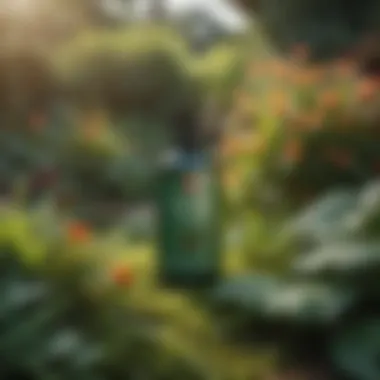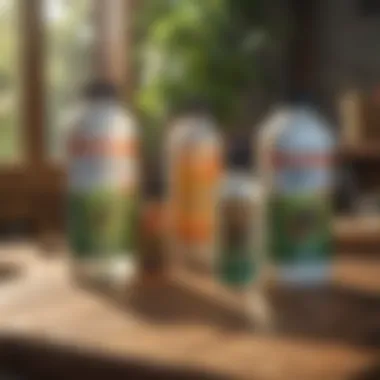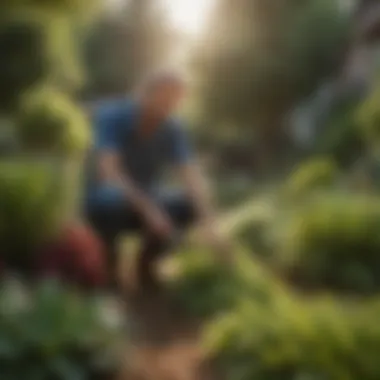Top Strategies for Effective Bug Treatment in Your Yard


Intro
Managing pests in your yard is more than just an aesthetic concern. It plays a crucial role in maintaining the overall health of your outdoor space. The right bug treatment techniques can help you cultivate a thriving garden while minimizing the adverse effects pests can cause to your plants and well-being. In this article, we will investigate various pest control methods. We will examine both chemical and eco-friendly solutions to aid homeowners in making informed decisions. This exploration begins with understanding pests, prevention methods, and ultimately, the most effective techniques for treatment.
Understanding Pests
Definition of Pests
Pests are organisms that can negatively impact the health of plants and human habitats. This includes insects, rodents, and even weeds. Most commonly, when discussing yard pests, we refer to insects such as aphids, mosquitoes, and grubs. These pests consume plant materials, spread diseases, and even cause physical damage to structures.
Importance of Pest Identification
Correctly identifying the type of pest is fundamental in developing an efficient treatment strategy. Various pests demand different control approaches. For instance, chemical pesticides may be effective for certain insects but ineffective or harmful for others. It is essential to assess the specific characteristics of the pest before applying any treatment. Knowledge gained from resources such as Wikipedia and Britannica can greatly aid in identification.
"Understanding what type of pest you’re dealing with is crucial before implementing treatment solutions."
Prevention Techniques
Implementing prevention techniques is often the most effective strategy for pest management. This can dramatically reduce the incidence of pest invaders in your yard.
Home and Garden Preventative Measures
- Maintain Cleanliness: Remove debris and standing water to deter pests that breed in these conditions.
- Regular Inspection: Routinely check for signs of infestations and promptly remove affected plants.
- Choose Resistant Varieties: Some plant species are more resistant to pests. Selecting these can be a wise choice when designing a garden.
Seasonal Prevention Tips
- Spring: Inspect for any signs of overwintering pests.
- Summer: Implement barriers, such as row covers, especially during peak insect activity.
- Fall: Prepare your garden for winter by cleaning and mulching to reduce overwintering pests.
Eco-Friendly Pest Control Solutions
As awareness grows regarding environmental issues, many homeowners are looking for sustainable pest control methods.
Overview of Sustainable Practices
Sustainable pest control practices prioritize the health of ecosystems. This includes encouraging beneficial insects, such as ladybugs and lacewings, which naturally control pest populations.
Natural Remedies and Their Effectiveness
Several natural remedies can be effective against common pests:
- Neem Oil: Derived from the seeds of the neem tree, it disrupts the life cycle of pests.
- Diatomaceous Earth: A natural powder that kills insects by dehydrating them.
- Essential Oils: Certain oils, such as peppermint and clove, are known to repel pests without the use of chemicals.
These methods are often safer for pets and humans, aligning with a more natural approach to yard management.
In closing, understanding pests and applying the right preventative techniques can immensely improve your yard's health. While chemical solutions may offer quick fixes, eco-friendly methods promote better long-term results. Choose the treatment solutions that align with your values and gardening goals.
Prolusion to Yard Pests
Yard pests can be a significant concern for homeowners and gardening enthusiasts. Understanding these pests and their behaviors is crucial for effective pest management. This section aims to clarify the types of pests that commonly invade outdoor spaces and the problems they pose. By recognizing the importance of addressing yard pests, you can take proactive steps toward maintaining a beautiful and healthy yard.
Understanding Common Yard Pests
In any outdoor setting, various pests can emerge, including insects, rodents, and other small animals. Some of the most common pests include aphids, mosquitoes, ticks, and grubs. Each of these pests has unique feeding habits and behaviors, causing different types of damage to plants, lawns, and even structures.


Aphids often cluster on newly planted shoots and can sap vital nutrients from plants. Mosquitoes breed in standing water, multiplying rapidly and creating an uncomfortable environment during warm months. Ticks can pose serious health risks to pets and humans alike. They hide in tall grass and wait for a host to latch onto. Lastly, grubs feed on grassroots, leading to patchy, unhealthy lawns.
Identifying these common pests is only the first step. It is also essential to understand their life cycles and the environmental conditions that favor their populations. This knowledge enables targeted treatments that can effectively control or eliminate these pests.
Impact of Pests on Outdoor Spaces
The presence of pests in your yard can lead to various negative impacts. They can disrupt the balance of your outdoor ecosystem, ruin landscaping efforts, and create health hazards for humans and pets. For instance, a lawn overrun by grubs might exhibit wilting patches, making your yard less visually appealing.
Furthermore, certain pests may carry diseases. Mosquitoes are notorious for transmitting West Nile Virus and Zika Virus, while ticks can transmit Lyme disease. These health concerns necessitate vigilant monitoring and treatment strategies for pest management.
Maintaining a pest-free yard not only enhances aesthetic appeal but also contributes to the overall health of the environment.
"Pests not only invade our spaces but also challenge our outdoor experiences, making awareness and management critical to yard health."
Types of Bug Treatments
Understanding the various types of bug treatments available is crucial for any homeowner. These methods not only address current infestations but also help in preventing future occurrences. Different treatments offer a range of benefits and can be tailored to suit individual preferences and environmental considerations. Choosing the right type of treatment can help you maintain a healthy yard while minimizing risks to your family and pets.
Chemical Treatments
Chemical treatments are often the first line of defense against stubborn pest issues. They can be effective at quickly eliminating a variety of insects. However, they also come with specific considerations that homeowners must keep in mind.
Types of Chemical Insecticides
Insecticides can be categorized into several types - pyrethroids, neonicotinoids, and organophosphates. Each type has unique characteristics that affect its efficacy and safety. Pyrethroids, for example, are popular due to their low toxicity to humans and pets. They act fast on a wide range of pests, making them a preferred choice for immediate relief. On the other hand, neonicotinoids are known for targeting the nervous systems of insects but may pose risks to beneficial populations as well. Understanding these distinctions is vital in selecting the right insecticide for your needs.
Application Methods
Applying chemical treatments requires careful consideration of methods to ensure effectiveness and safety. Common application methods include sprays, granules, and drenching. Sprays are versatile and can be applied directly to affected areas, while granules offer a more targeted approach. Drenching involves applying a liquid solution directly to the soil, targeting root pests. Each method has its advantages. For instance, sprays can cover large areas quickly, while granules can persist in the environment longer. Awareness of the application technique is essential to maximize results.
Safety Considerations
Safety is paramount when using chemical treatments. Homeowners must consider exposure risks to humans, pets, and local wildlife. Always read product labels and follow safety guidelines. Additionally, using personal protective equipment (PPE) during application can minimize risk. Another important safety aspect is timing; applying treatments during calm weather can prevent drift and unintended exposure. By prioritizing safety, you can effectively manage pests while protecting your loved ones.
Eco-Friendly Solutions
With growing awareness surrounding environmental impact, eco-friendly solutions have gained popularity among homeowners. These treatments can effectively manage pests while minimizing harm to ecosystems.
Natural Remedies
Natural remedies, such as neem oil and diatomaceous earth, offer a chemical-free way to handle pests. These treatments disrupt pest life cycles without harming beneficial insects. Neem oil works as an insect repellent and disrupts feeding behaviors of various pests. Diatomaceous earth is particularly effective against soft-bodied insects and is easy to apply. One of the significant advantages of using natural remedies is the minimal risk posed to human and pet safety, making them a thoughtful choice for families.
Beneficial Insects
Encouraging beneficial insects, such as ladybugs and lacewings, can assist in pest control organically. These insects prey on common yard pests, thus helping to keep populations in check. Implementing companion planting and creating habitats for these beneficial insects can be an effective way to manage pests naturally. The unique feature of using beneficial insects is that they create a sustainable environment, reducing reliance on chemical methods over time.
Essential Oils
Essential oils like peppermint, tea tree, and lavender can deter pests through their strong scents. These oils can be diluted and sprayed or used in diffusers to create a barrier against insects. The key characteristic that makes essential oils attractive is their low environmental impact and pleasant aroma, which won’t harm your yard. However, they tend to provide a shorter-term solution compared to other treatments, which is an essential factor to consider.
Integrated Pest Management (IPM)
Integrating various treatment methods through Integrated Pest Management (IPM) can enhance effectiveness while minimizing negative impacts. This holistic approach combines both chemical and eco-friendly solutions tailored to specific yard needs.


Principles of IPM
The principles of IPM focus on understanding pest life cycles, monitoring infestations, and applying treatments only when necessary. This systematic approach allows homeowners to make informed decisions, ensuring pests are controlled effectively without excessive use of chemicals. The adaptability of IPM strategies is a key benefit, catering to the unique challenges each yard may present.
Monitoring and Assessment
Regular monitoring and assessment are prime components of IPM. Homeowners should routinely check for signs of infestation, which promotes early detection and targeted action. Conducting assessments takes minimal time and drastically increases the chances of effective treatment before a problem escalates. Staying informed helps you adjust your strategy based on observed pest dynamics.
Combining Treatment Methods
An essential aspect of IPM is the ability to combine treatment methods effectively. For example, mixing chemical sprays with natural remedies can strike a balance between immediate pest control and long-term sustainability. By integrating these methods, homeowners can optimize their pest management efforts, ensuring that they are not solely reliant on one approach.
Identifying the Right Treatment for Your Yard
Identifying the right treatment for your yard is critical for effective pest control. Homeowners often face challenges in managing pests while preserving the health of plants and the environment. Selecting a treatment involves careful consideration of several factors, including the type of pest, environmental impact, and safety for humans and pets. By understanding these elements, homeowners can make informed decisions that benefit their yards and overall landscape.
Assessing Pest Infestation Levels
Assessing the level of pest infestation is the first step in choosing the appropriate treatment. Observing your yard regularly will help identify the signs of pest activity. Look for noticeable damage to plants, such as holes in leaves or wilting. Additionally, pest droppings or shed exoskeletons can be indicators of an existing infestation. By accurately gauging the severity of the infestation, you can select a treatment method that aligns with your needs. If the infestation is mild, eco-friendly measures may suffice, whereas severe infestations might necessitate more aggressive chemical treatments.
Factors to Consider for Treatment Choice
Type of Pest
Understanding the type of pest in your yard is essential. Different pests require distinct approaches for control. For example, aphids commonly damage roses and other plants, necessitating targeted insecticidal treatments. In contrast, grubs can affect lawns and might require specific nematodes for effective control. Each pest type has unique characteristics that affect its impact on your yard, therefore identifying the pest correctly can lead to more effective treatment decisions.
Environmental Impact
Environmental impact is a significant consideration when choosing a treatment method. Chemical pesticides can offer quick results but often have adverse effects on non-target organisms. These might include beneficial insects and soil quality. On the other hand, eco-friendly methods, such as neem oil or diatomaceous earth, pose less risk to the surrounding ecosystem. The unique feature of eco-friendly treatments is their ability to minimize harm while effectively managing pest populations. Therefore, balancing a strategy that protects both your plants and the environment is vital in pest management.
Human and Pet Safety
Safety for both humans and pets is paramount when selecting a pest control method. Many chemical treatments can pose health risks if not used correctly. Options labeled as organic, such as insecticidal soaps or essential oils, are generally safer alternatives. The emphasis on safety is crucial because you want a pest-free yard without compromising the well-being of family members and pets. By prioritizing safety, you can effectively choose solutions that minimize risks while still managing pest issues in your yard.
"Choosing the right treatment entails understanding the nuances of both the pests and the control methods available. This process ensures that decisions made are both effective and safe."
In summary, identifying the right treatment for your yard requires thorough assessment and awareness of various influencing factors. Recognizing pest infestation levels, the type of pest present, the environmental impact of treatments, and safety concerns play significant roles in tailoring effective pest management strategies.
Application Techniques
Effective bug treatment in your yard relies not only on the choice of products but also on the methods of application. Proper application techniques ensure that treatments reach the intended pests while minimizing impact on non-target species, including beneficial insects and humans. This section focuses on the essential elements of application techniques, emphasizing their crucial role in enhancing the efficacy of pest control measures.
Timing and Frequency of Application
When it comes to pest control, understanding the optimal timing and frequency of application is vital. Many pests have specific life cycles that can influence the success of treatments. For instance, applying insecticides during the peak activity periods can maximize effectiveness. Here are several points to consider regarding timing:
- Seasonal Considerations: During spring and early summer, many common pests are in their most active development stages. This makes it an ideal time for treatments.
- Pest Behavior: Certain pests may exhibit specific behaviors, such as nocturnal activity. Treating your yard in the evening may yield better results for such pests.
- Weather Conditions: Avoid applying treatments before heavy rainfall, as water can wash away chemical treatments, reducing effectiveness.
It's often beneficial to monitor the pest population in your yard throughout the year, allowing you to schedule treatments when needed.
Tools and Equipment Needed
The right tools and equipment can significantly enhance the application of pest control treatments. When selecting tools, consider what will best suit your yard's size and the types of treatments you plan to use. Useful equipment includes:


- Sprayers: Handheld or backpack sprayers allow for targeted application of liquid treatments.
- Granule Spreaders: For granular insecticides, a spreader can provide uniform distribution across the lawn and garden.
- Personal Protective Equipment (PPE): Gloves, masks, and goggles are critical for protecting yourself during application, especially when using chemical treatments.
- Measuring Tools: Accurate measuring cups or spoons ensure that you apply the correct dosage, which is essential for effectiveness and safety.
Using the appropriate tools will help you achieve a more efficient treatment process and protect your yard while ensuring safety.
By focusing on proper timing and employing suitable tools, your pest control efforts will be more successful and sustainable, ensuring a thriving outdoor space.
Maintaining a Pest-Free Yard
Maintaining a pest-free yard is crucial for various reasons. It not only protects the aesthetic appeal of your outdoor space but also ensures the health of your plants, pets, and family. A well-maintained yard acts as a barrier against pest invasions. By implementing effective preventative measures, homeowners can minimize the chances of severe pest infestations occurring. This section explores practical strategies, focusing on proactive techniques to maintain a vibrant and pest-resistant yard.
Preventative Measures
Proper Yard Maintenance
Proper yard maintenance plays a significant role in preventing pest problems. Regularly mowing your lawn keeps grass at an optimal height, which discourages pests from taking root. Removing dead leaves, debris, and weeds reduces hiding places for pests. Furthermore, a healthy lawn and garden can resist pest damage. Fertilizing and watering plants adequately is essential for their growth. This not only enhances beauty but also strengthens plants, making them less appealing to pests. The consistent upkeep of the yard helps maintain biodiversity, which in turn influences pest presence positively.
One key characteristic of proper yard maintenance is its simplicity. Homeowners can perform these tasks without the need for extensive technical knowledge. Certainly, it is beneficial for this article as it empowers house owners to take action against pests actively.
However, a drawback can be the time commitment involved. Consistency is vital; neglecting routine efforts can lead to unexpected infestations.
Attracting Predatory Insects
Attracting predatory insects can naturally control pest populations in the garden. Beneficial insects such as ladybugs, lacewings, and predatory wasps can significantly reduce the number of pest insects without harmful chemicals. Planting flowers like marigolds, dill, or fennel can invite these beneficial species into your yard.
This approach emphasizes the ability of nature to balance ecosystems. Unlike chemical solutions, attracting predatory insects is a sustainable choice. It fosters a healthier environment, promoting biodiversity. The unique feature of this method lies in its non-invasive nature, protecting not just plants but the entire ecosystem. However, it’s important to understand that keeping a consistent population of predatory insects may take time. Additionally, some beneficial insects require specific environmental conditions to thrive.
Use of Barriers and Traps
Using barriers and traps is another effective measure for maintaining a pest-free yard. Barriers such as row covers protect specific plants from pests while allowing light and air to circulate. They can deter larger pests like birds or rabbits as well. On the other hand, traps help in monitoring pest presence and, if needed, can significantly reduce their numbers.
The key characteristic of using barriers and traps is their immediate effectiveness. A well-placed trap can reveal pest activity promptly and help homeowners act before infestations escalate. Barriers are often low-cost solutions that require minimal installation efforts.
However, there are limits to their applicability. Traps need regular checking and maintenance; otherwise, they may become ineffective. Over-reliance on traps without other methods can lead to problems if the underlying issues remain unaddressed.
Monitoring for Future Infestations
Monitoring is critical in maintaining a pest-free yard. Routine checks for signs of infestation or damage can alert homeowners to potential issues quickly. By regularly inspecting plants and soil, it becomes easier to identify invasive species or pests before they propagate. This proactive strategy ensures that pest management is part of an ongoing process rather than just a reactive one after an infestation occurs.
Epilogue
When considering the management of pests in your yard, it is crucial to understand the effective strategies presented in this article. Summarizing the various bug treatment techniques, from chemical options to more eco-friendly solutions, allows homeowners to select practical methods tailored to their specific situations. The adoption of these methods promotes not only a healthier outdoor environment but also minimizes risk to humans and animals nearby.
Summarizing Effective Bug Treatment Strategies
Effective bug treatment strategies hinge on two main areas: understanding pest behaviors and applying the right interventions.
- Identify the pests that are affecting your yard. This involves careful observation and possibly consultation with experts.
- Choose the method that aligns with your values and circumstances, whether that's using chemical treatments or employing more natural solutions such as introducing beneficial insects.
- Implement treatments properly. Follow guidelines for timing, dosage, and safety. Timing can vary between day and night, as some pests are more active during specific times.
- Monitor the results and adapt strategies as necessary. Keeping track of what works will help refine your approach over time.
The most effective pest control strategy is an ongoing process, requiring adaptability and a commitment to learning.
Encouraging Ongoing Education and Research
Staying current on pest management is essential for anyone responsible for maintaining outdoor spaces. Continued education helps in recognizing new pests and emerging control methods, while research expands the knowledge base.
- Follow reputable sources. Websites like Wikipedia and Britannica can provide foundational knowledge on pest behavior and treatments.
- Engage with fellow homeowners. Online forums or community discussions on platforms like Reddit or Facebook can be invaluable resources for shared experiences.
- Attend workshops or local gardening club meetings. These provide hands-on experience and insights from seasoned gardeners.
The landscape of pest management is dynamic. By committing to ongoing education and remaining proactive, homeowners can maintain a flourishing yard.
By synthesizing these elements, readers will be equipped to tackle pest problems efficiently and responsibly.



